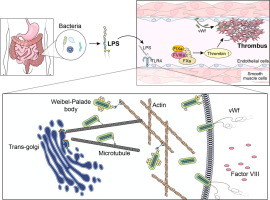当前位置:
X-MOL 学术
›
J. Hepatol.
›
论文详情
Our official English website, www.x-mol.net, welcomes your feedback! (Note: you will need to create a separate account there.)
Gut-derived endotoxin stimulates factor VIII secretion from endothelial cells. Implications for hypercoagulability in cirrhosis
Journal of Hepatology ( IF 25.7 ) Pub Date : 2017-11-01 , DOI: 10.1016/j.jhep.2017.07.002 Roberto Carnevale , Valeria Raparelli , Cristina Nocella , Simona Bartimoccia , Marta Novo , Anna Severino , Elena De Falco , Vittoria Cammisotto , Chiara Pasquale , Clara Crescioli , Antonio Sili Scavalli , Oliviero Riggio , Stefania Basili , Francesco Violi
Journal of Hepatology ( IF 25.7 ) Pub Date : 2017-11-01 , DOI: 10.1016/j.jhep.2017.07.002 Roberto Carnevale , Valeria Raparelli , Cristina Nocella , Simona Bartimoccia , Marta Novo , Anna Severino , Elena De Falco , Vittoria Cammisotto , Chiara Pasquale , Clara Crescioli , Antonio Sili Scavalli , Oliviero Riggio , Stefania Basili , Francesco Violi

|
BACKGROUND & AIMS
Patients with cirrhosis display enhanced blood levels of factor VIII, which may result in harmful activation of the clotting system; however, the underlying mechanism is unknown. METHODS
We performed a cross-sectional study in patients with cirrhosis (n=61) and matched controls (n=61) comparing blood levels of factor VIII, von Willebrand factor (vWf), lipopolysaccharide (LPS) and positivity for Escherichia coli DNA. Furthermore, we performed an in vitro study to investigate if LPS, in a concentration range similar to that found in the peripheral circulation of cirrhotic patients, was able to elicit factor VIII secretion from human umbilical vein endothelial cells (HUVEC). RESULTS
Patients with cirrhosis displayed higher serum levels of LPS (55.8 [42.2-79.9] vs. 23.0 [7.0-34.0]pg/ml, p<0.001), factor VIII (172.0 [130.0-278.0] vs. 39.0 [26.0-47.0]U/dl, p<0.0001), vWf (265.0 [185.0-366.0] vs. 57.0 [48.0-65.0]U/dl, p<0.001) and positivity for Escherichia coli DNA (88% vs. 3%, p<0.001, n=34) compared to controls. Serum LPS correlated significantly with factor VIII (r=0.80, p<0.001) and vWf (r=0.63, p<0.001). Only LPS (beta-coefficient=0.70, p<0.0001) independently predicted factor VIII levels. The in vitro study showed that LPS provoked factor VIII and vWf release from HUVEC via formation and secretion of Weibel-Palade bodies, a phenomenon blunted by pre-treating HUVEC with an inhibitor of Toll-like receptor 4. CONCLUSIONS
The study provides the first evidence that LPS derived from gut microbiota increases the systemic levels of factor VIII via stimulating its release by endothelial cells. Lay summary: Cirrhosis is associated with thrombosis in portal and systemic circulation. Enhanced levels of factor VIII have been suggested to play a role but the underlying mechanism is still unclear. Here we show that patients with cirrhosis display a concomitant increase of factor VIII and lipopolysaccharide (LPS) from Escherichia coli and suggest that LPS contributes to the release of factor VIII from endothelial cells.
中文翻译:

肠源性内毒素刺激内皮细胞分泌因子 VIII。对肝硬化高凝状态的影响
背景和目的 肝硬化患者血液中凝血因子 VIII 水平升高,这可能导致凝血系统的有害激活;然而,潜在的机制是未知的。方法 我们在肝硬化患者 (n=61) 和匹配对照 (n=61) 中进行了一项横断面研究,比较了凝血因子 VIII、血管性血友病因子 (vWf)、脂多糖 (LPS) 的血液水平和大肠杆菌 DNA 的阳性。此外,我们进行了一项体外研究,以调查浓度范围与肝硬化患者外周循环中发现的浓度范围相似的 LPS 是否能够引起人脐静脉内皮细胞 (HUVEC) 分泌因子 VIII。结果 肝硬化患者的 LPS 血清水平较高(55.8 [42.2-79.9] vs. 23.0 [7.0-34.0]pg/ml,p<0.001),因子Ⅷ(172.0 [130.0-278. 0] vs. 39.0 [26.0-47.0]U/dl, p<0.0001), vWf (265.0 [185.0-366.0] vs. 57.0 [48.0-65.0]U/dl, p<0.001) 和大肠杆菌DNA(埃舍尔氏菌阳性) 88% vs. 3%, p<0.001, n=34) 与对照相比。血清 LPS 与因子 VIII (r=0.80, p<0.001) 和 vWf (r=0.63, p<0.001) 显着相关。只有 LPS(β 系数 = 0.70,p<0.0001)独立预测因子 VIII 水平。体外研究表明,LPS 通过 Weibel-Palade 小体的形成和分泌引起 HUVEC 的因子 VIII 和 vWf 释放,这种现象通过用 Toll 样受体 4 抑制剂预处理 HUVEC 减弱。结论该研究提供了第一个证据来自肠道微生物群的 LPS 通过刺激内皮细胞释放因子 VIII 来增加因子 VIII 的全身水平。奠定总结:肝硬化与门静脉和体循环中的血栓形成有关。已建议因子 VIII 的水平升高发挥作用,但潜在机制仍不清楚。在这里,我们显示肝硬化患者同时增加了来自大肠杆菌的因子 VIII 和脂多糖 (LPS),并表明 LPS 有助于内皮细胞释放因子 VIII。
更新日期:2017-11-01
中文翻译:

肠源性内毒素刺激内皮细胞分泌因子 VIII。对肝硬化高凝状态的影响
背景和目的 肝硬化患者血液中凝血因子 VIII 水平升高,这可能导致凝血系统的有害激活;然而,潜在的机制是未知的。方法 我们在肝硬化患者 (n=61) 和匹配对照 (n=61) 中进行了一项横断面研究,比较了凝血因子 VIII、血管性血友病因子 (vWf)、脂多糖 (LPS) 的血液水平和大肠杆菌 DNA 的阳性。此外,我们进行了一项体外研究,以调查浓度范围与肝硬化患者外周循环中发现的浓度范围相似的 LPS 是否能够引起人脐静脉内皮细胞 (HUVEC) 分泌因子 VIII。结果 肝硬化患者的 LPS 血清水平较高(55.8 [42.2-79.9] vs. 23.0 [7.0-34.0]pg/ml,p<0.001),因子Ⅷ(172.0 [130.0-278. 0] vs. 39.0 [26.0-47.0]U/dl, p<0.0001), vWf (265.0 [185.0-366.0] vs. 57.0 [48.0-65.0]U/dl, p<0.001) 和大肠杆菌DNA(埃舍尔氏菌阳性) 88% vs. 3%, p<0.001, n=34) 与对照相比。血清 LPS 与因子 VIII (r=0.80, p<0.001) 和 vWf (r=0.63, p<0.001) 显着相关。只有 LPS(β 系数 = 0.70,p<0.0001)独立预测因子 VIII 水平。体外研究表明,LPS 通过 Weibel-Palade 小体的形成和分泌引起 HUVEC 的因子 VIII 和 vWf 释放,这种现象通过用 Toll 样受体 4 抑制剂预处理 HUVEC 减弱。结论该研究提供了第一个证据来自肠道微生物群的 LPS 通过刺激内皮细胞释放因子 VIII 来增加因子 VIII 的全身水平。奠定总结:肝硬化与门静脉和体循环中的血栓形成有关。已建议因子 VIII 的水平升高发挥作用,但潜在机制仍不清楚。在这里,我们显示肝硬化患者同时增加了来自大肠杆菌的因子 VIII 和脂多糖 (LPS),并表明 LPS 有助于内皮细胞释放因子 VIII。



























 京公网安备 11010802027423号
京公网安备 11010802027423号